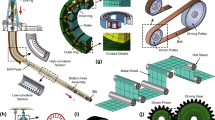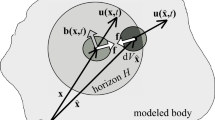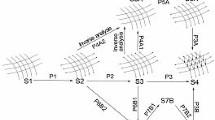Abstract
In this paper, a SMA space-time ANCF cable element which based on an asymmetric Brinson constitutive model (Poorasadion model) is proposed. To solve the discontinuity of stress in cross section, 5-order polynomial interpolation in neutral axis is used in shape function to construct the displacement formulation of the presented element. The continuity of position and velocity is also guaranteed by 3-order polynomial interpolation in the time direction. The stress equation based on the stress distribution in the neutral axis and cross section is derived. The phase transition regions are given in detail, and the update strategy of initial state parameter for the constitutive law is determined. In the space-time discretization, a solver based on Hamilton’s law of varying action and P2 method is established. As for constrains, the application methods of replaceable constraint and supplementary constraint are proposed to solve the singular problems in Jacobian matrix. Numerical simulation verifies that this method is capable of simulating the cyclic loading of thermo-mechanic problems. A free pendulum simulation shows the difference between the variation of stress and component of detwinned martensite. Simulation results also show that this element could be used for capturing the shape memory effect and pseudo-elasticity effect by SMA cable and the asymmetric effect in tension and compression by adopting an asymmetric constitutive law.














Similar content being viewed by others
References
Buehler, W.J., Gilfrich, J.V., Wiley, R.C.: Effect of low-temperature phase changes on the mechanical properties of alloys near composition TiNi. J. Appl. Phys. 34, 1475–1477 (1963). https://doi.org/10.1063/1.1729603
Zaki, W., Moumni, Z.: A three-dimensional model of the thermomechanical behavior of shape memory alloys. J. Mech. Phys. Solids 55(11), 2455–2490 (2007). https://doi.org/10.1016/j.jmps.2007.03.012
Suzuki, Y., Kagawa, Y.: Dynamic tracking control of an SMA wire actuator based on model matching. Sens. Actuators, A 292, 129–136 (2019). https://doi.org/10.1016/j.sna.2019.04.011
Victor, B. (1997) Effect of SMA dampers on nonlinear vibrations of elastic structures. In: Varadan VV, Chandra J, (Eds.) Smart Structures and Materials 1997, Mathematics and Control in Smart Structures. p. 268–76.
Li, S., Wang, J.-Q., Shahria Alam, M.: Multi-criteria optimal design and seismic assessment of SMA RC piers and SMA cable restrainers for mitigating seismic damage of simply-supported highway bridges. Eng. Struct. 252, 113547 (2022). https://doi.org/10.1016/j.engstruct.2021.113547
Wang, J.-Q., Li, S., Hedayati Dezfuli, F., Alam, M.S.: Sensitivity analysis and multi-criteria optimization of SMA cable restrainers for longitudinal seismic protection of isolated simply supported highway bridges. Eng. Struct. 189, 509–522 (2019). https://doi.org/10.1016/j.engstruct.2019.03.091
Terriault, P., Viens, F., Brailovski, V.: Non-isothermal finite element modeling of a shape memory alloy actuator using ANSYS. Comput. Mater. Sci. 36(4), 397–410 (2006). https://doi.org/10.1016/j.commatsci.2005.05.010
Zhou, B., Kang, Z., Wang, Z., Xue, S.: finite element method on shape memory alloy structure and its applications. Chin. J. Mech. Eng. 32(1), 1–1 (2019). https://doi.org/10.1186/s10033-019-0401-3
Kundu, A., Banerjee, A.: Coupled thermomechanical modelling of shape memory alloy structures undergoing large deformation. Int. J. Mech. Sci. 220, 107102 (2022). https://doi.org/10.1016/j.ijmecsci.2022.107102
Liang, C., Rogers, C.A.: A multi-dimensional constitutive model for shape memory alloys. J. Eng. Math. 26(3), 429–443 (1992). https://doi.org/10.1007/BF00042744
Liang, C., Rogers, A.: One-dimensional thermomechanical constitutive relations for shape memory materials. J. Intell. Mater. Syst. Struct. 8(4), 285–302 (1997). https://doi.org/10.1177/1045389X9700800402
Brinson, L.C., Lammering, R.: Finite element analysis of the behavior of shape memory alloys and their applications. Int. J. Solids Struct. 30(23), 3261–3280 (1993). https://doi.org/10.1016/0020-7683(93)90113-L
Brinson, L.C., Bekker, A., Hwang, S.: Deformation of shape memory alloys due to thermo-induced transformation. J. Intell. Mater. Syst. Struct. 7(1), 97–107 (1996). https://doi.org/10.1177/1045389x9600700111
Chung, J.-H., Heo, J.-S., Lee, J.-J.: Implementation strategy for the dual transformation region in the Brinson SMA constitutive model. Smart Mater. Struct. 16(1), N1–N5 (2007). https://doi.org/10.1088/0964-1726/16/1/n01
Poorasadion, S., Arghavani, J., Naghdabadi, R., Sohrabpour, S.: An improvement on the Brinson model for shape memory alloys with application to two-dimensional beam element. J. Intell. Mater. Syst. Struct. 25(15), 1905–1920 (2013). https://doi.org/10.1177/1045389x13512187
Ostadrahimi, A., Arghavani, J., Poorasadion, S.: An analytical study on the bending of prismatic SMA beams. Smart Mater. Struct. 24(12), 125035 (2015). https://doi.org/10.1088/0964-1726/24/12/125035
Samadi-Aghdam, K., Fahimi, P., Baniassadi, M., Baghani, M.: Development and implementation of a geometrically nonlinear beam theory model for SMA composite beams with asymmetric behavior. Compos. Struct. 259, 113417 (2021). https://doi.org/10.1016/j.compstruct.2020.113417
Christ, D., Reese, S.: Finite-element modelling of shape memory alloys—A comparison between small-strain and large-strain formulations. Mater. Sci. Eng., A 481–482, 343–346 (2008). https://doi.org/10.1016/j.msea.2006.11.174
Christ, D., Reese, S.: A finite element model for shape memory alloys considering thermomechanical couplings at large strains. Int. J. Solids Struct. 46(20), 3694–3709 (2009). https://doi.org/10.1016/j.ijsolstr.2009.06.017
Shabana, A.A.:An absolute nodal coordinate formulation for the large rotation and deformation analysis of flexible bodies, 1996.
Shabana, A., Yakoub, R.: Three dimensional absolute nodal coordinate formulation for beam elements: theory. J. Mech. Design. 123, 606–613 (2001). https://doi.org/10.1115/1.1410100
Lan, P., Li, K., Yu, Z.: Computer implementation of piecewise cable element based on the absolute nodal coordinate formulation and its application in wire modeling. Acta Mech. 230(3), 1145–1158 (2019). https://doi.org/10.1007/s00707-018-2332-y
Vaziri Sereshk, M.R., Salimi, M.: Comparison of finite element method based on nodal displacement and absolute nodal coordinate formulation (ANCF) in thin shell analysis. Int. J. Numer. Method Biomed. Eng. 27, 1185–1198 (2011). https://doi.org/10.1002/cnm.1348
Schwab, A.L., Gerstmayr, J., Meijaard, J.P.:Comparison of three-dimensional flexible thin plate elements for multibody dynamic analysis: finite element formulation and absolute nodal coordinate formulation. In: ASME 2007 International Design Engineering Technical Conferences and Computers and Information in Engineering Conference2007. p. 1059–70.
Liu, J., Hong, J., Cui, L.: An exact nonlinear hybrid-coordinate formulation for flexible multibody systems. Acta. Mech. Sin. 23(6), 699–706 (2007). https://doi.org/10.1007/s10409-007-0118-x
Shen, Z., Tian, Q., Liu, X., Hu, G.: Thermally induced vibrations of flexible beams using absolute nodal coordinate formulation. Aerosp. Sci. Technol. 29, 386–393 (2013). https://doi.org/10.1016/j.ast.2013.04.009
Cui, Y., Lan, P., Zhou, H., Yu, Z.: The rigid-flexible-thermal coupled analysis for spacecraft carrying large aperture paraboloid antenna. J. Comput. Nonlinear Dyn. 1515(3), 031003 (2020). https://doi.org/10.1115/1.4045890
Zhang, P., Duan, M., Gao, Q., Ma, J., Wang, J., Sævik, S.: Efficiency improvement on the ANCF cable element by using the dot product form of curvature. Appl. Math. Model. 102, 435–452 (2022). https://doi.org/10.1016/j.apm.2021.09.027
Bulín, R., Hajžman, M.: Efficient computational approaches for analysis of thin and flexible multibody structures. Nonlinear Dyn. 103(3), 2475–2492 (2021). https://doi.org/10.1007/s11071-021-06225-5
Hu, W., Tian, Q., Hu, H.: Dynamic fracture simulation of flexible multibody systems via coupled finite elements of ANCF and particles of SPH. Nonlinear Dyn. 84(4), 2447–2465 (2016). https://doi.org/10.1007/s11071-016-2657-9
Huang, H., Costanzo, F.: On the use of space-time finite elements in the solution of elasto-dynamic problems with strain discontinuities. Comput. Methods Appl. Mech. Eng. 191(46), 5315–5343 (2002). https://doi.org/10.1016/S0045-7825(02)00460-7
Hulbert, G.M., Hughes, R.: Space-time finite element methods for second-order hyperbolic equations. Comput. Methods Appl. Mech. Eng. 84(3), 327–348 (1990). https://doi.org/10.1016/0045-7825(90)90082-W
Argyris, J.H., Scharpf, D.W.: Finite elements in time and space. Nucl. Eng. Des. 10(4), 456–464 (1969). https://doi.org/10.1016/0029-5493(69)90081-8
Warzee, G.: Finite element analysis of transient heat conduction application of the weighted residual process. Comput. Methods Appl. Mech. Eng. 3(2), 255–268 (1974). https://doi.org/10.1016/0045-7825(74)90028-0
Aziz, A.K., Monk, P.: continuous finite elements in space and time for the heat equation. Math. Comput. 52(186), 255–274 (1989). https://doi.org/10.2307/2008467
Zhong, W., Yao, Z.: Time domain FEM and symplectic conservation ( in Chinese). J. Mech. Strength. 02, 178–183 (2005). https://doi.org/10.16579/j.issn.1001.9669.2005.02.009
Zhong, W., Gao, Q.: Space-time mixed FEM (in Chinese). J. Dyn. Control. 01, 1–7 (2007)
Gao, Q., Peng, H., Zhang, H., Zhong, W.: The symplectic algorithms for Hamiltonian dynamic systems based on a new variational principle part I: the variational principle and the algorithms (in Chinese). Chin. J. Comput. Mech. 30(04), 461–467 (2013)
Gao, Q., Peng, H., Zhang, H., Zhong, W.: The symplectic algorithms for Hamiltonian dynamic systems based on a new variational principle part II: the proof of the symplecticity (in Chinese). Chin. J. Comput. Mech. 30(04), 468–472 (2013)
Gao, Q., Peng, H., Zhang, H., Zhong, W.: The symplectic algorithms for Hamiltonian dynamic systems based on a new variational principle part III: the numerical examples (in Chinese). Chin. J. Comput. Mech. 30(04), 473–478 (2013)
Sánchez, M.A., Cockburn, B., Nguyen, N.-C., Peraire, J.: Symplectic Hamiltonian finite element methods for linear elastodynamics. Comput. Methods Appl. Mech. Eng. 381, 113843 (2021). https://doi.org/10.1016/j.cma.2021.113843
Mergel, J.C., Sauer, R.A., Ober-Blöbaum, S.: C1-continuous space-time discretization based on Hamilton’s law of varying action. ZAMM J Appl Math Mech/Zeitschrift für Angewandte Math. und Mech. 97(4), 433–457 (2017). https://doi.org/10.1002/zamm.201600062
Mehrabi, R., Shirani, M., Kadkhodaei, M., Elahinia, M.: Constitutive modeling of cyclic behavior in shape memory alloys. Int. J. Mech. Sci. 103, 181–188 (2015). https://doi.org/10.1016/j.ijmecsci.2015.08.003
Buravalla, V., Khandelwal, A.: Evolution kinetics in shape memory alloys under arbitrary loading: experiments and modeling. Mech. Mater. 43, 807–823 (2011). https://doi.org/10.1016/j.mechmat.2011.08.012
Kang, W., Kim, E., Jeong, M.-S., Lee, I., Ahn, S.-M.: Morphing wing mechanism using an SMA wire actuator. Int. J. Aeronaut. Space Sci. 13, 58–63 (2012). https://doi.org/10.5139/IJASS.2012.13.1.58
Kim, M.K., Kim, D.J., Chung, Y.S., Choi, E.: Effects of a short heat treatment period on the pullout resistance of shape memory alloy fibers in mortar. Materials. 12(14), 2278 (2019). https://doi.org/10.3390/ma12142278
Acknowledgements
The work is supported by independent research project of State Key Laboratory of Green Building in West China [No. LSZZ202209] and the Technology Innovation Project of Hunan Province [No. 2018GK1040]
Author information
Authors and Affiliations
Corresponding author
Ethics declarations
Conflict of interest
The authors declare that they have no known competing financial interests or personal relationships that relationships that could have appeared to influence the work reported in this paper.
Additional information
Publisher's Note
Springer Nature remains neutral with regard to jurisdictional claims in published maps and institutional affiliations.
Appendix A: The martensite fraction calculation equations
Appendix A: The martensite fraction calculation equations
Equation (27) consists of three equations for martensite calculation fraction, which are used to calculate \(\xi_{T}\), \(\xi_{S}^{ + }\) and \(\xi_{S}^{ - }\). The martensite fraction equations are piecewise equations. The martensite fraction obeys the relation given in Table 6, when it is in the loading range given by PTR under normal loading stage, which means that the total martensite fraction \(\xi\) is not more than 1, and three martensite components are no less than 0. Several kinds of abnormal loading conditions are given in Table 7, which correspond to the abnormal conditions of the total martensite fraction and each martensite fraction, respectively. In particular, when the last three cases in Table 7 occur, only the constraint martensite component is constrained to 0, and the other martensite components still need to be calculated according to the corresponding calculation equations of the interval in Table 6.
Rights and permissions
Springer Nature or its licensor (e.g. a society or other partner) holds exclusive rights to this article under a publishing agreement with the author(s) or other rightsholder(s); author self-archiving of the accepted manuscript version of this article is solely governed by the terms of such publishing agreement and applicable law.
About this article
Cite this article
Chen, D., Cui, Y., Lan, P. et al. A two-dimensional space-time absolute nodal coordinates cable element and its application in shape memory alloy. Acta Mech 234, 3687–3707 (2023). https://doi.org/10.1007/s00707-023-03580-9
Received:
Revised:
Accepted:
Published:
Issue Date:
DOI: https://doi.org/10.1007/s00707-023-03580-9




